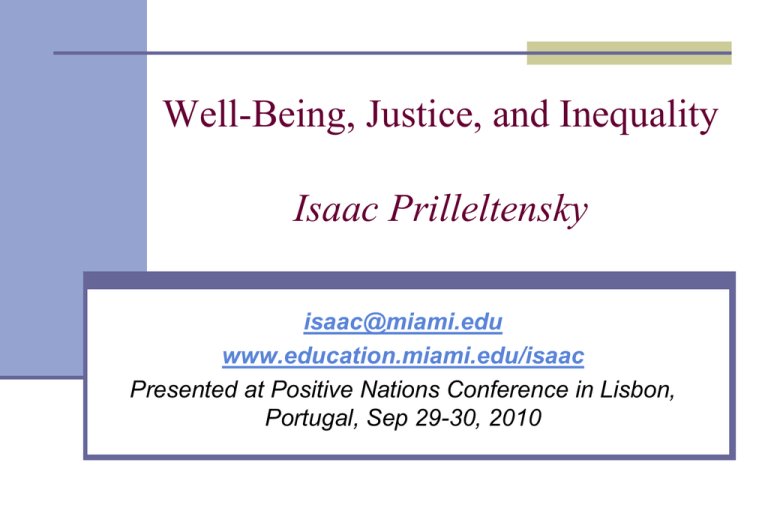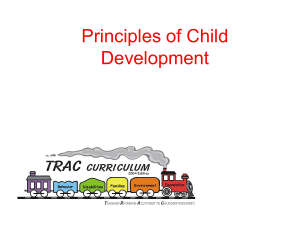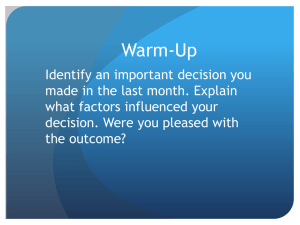Lorem Ipsum - University of Miami
advertisement

Well-Being, Justice, and Inequality Isaac Prilleltensky isaac@miami.edu www.education.miami.edu/isaac Presented at Positive Nations Conference in Lisbon, Portugal, Sep 29-30, 2010 Outline of Presentation Well-being Definition Research Justice Definition Research Inequalities and Inequities in Well-Being Definition Research Implications for domestic and international policy and practices Kerala: A Community Strengths Story Kerala: A state in Southwest India. The name "Kerala" probably means "land of coconuts." Population: 31.8 million Sen: Economic growth is not the whole story. Distribution also matters a great deal for health and human development. Indicator Kerala India Low income countries USA Per Capita GDP $ 566 460 420 34,260 Adult Literacy Rate (%) 91 58 39 96 Males (f) 68 63 59 74 Females (f) 74 64 Infant Mortality per 1,000 12 65 80 7 Birth Rate Per 1,000 17 29 40 16 Life Expectancy in Years 80 Processes Well-Being in Kerala Personal Empowerment Outcomes Personal Well-Being Infant mortality Literacy Nutrition Life expectancy Social Movements Relational And Organizational Well-Being Social support Sense of cohesion Government Action Community Well-Being Tenancy laws Nutrition in school Distribution Of resources Land reform Defining Well-Being Wellness is a positive state of affairs, brought about by the simultaneous satisfaction of personal, relational, organizational and collective needs Part I: Understanding Well-Being There cannot be well-being but in the combined presence of personal, relational, organizational and community well-being Personal Well-being Sense of control Physical health Love Optimism Competence Dignity and integrity Growth Self-esteem Meaning and spirituality Material resources Effects of lack of control and disempowerment on mortality Relational Well-Being Support Affection Bonding Cohesion Collaboration Respect for diversity Democratic participation Effects of Social Support Less likely to have heart attacks More likely to resist common cold virus Lower mortality Less degree of stress More positive outlook on life Resilience Organizational Well-Being Efficient structures Clear roles Monitoring mechanisms Planning and accountability Growth opportunities Fulfillment of needs Identity and meaning Organizational Well-Being: ERA Environments High Reflective Environment High Low Low Affective Environment Low High Effective Environment Employee engagement and outcome Employee engagement percentile Success rate 99 73% 95 67% 75 57% 50 50% 25 43% 5 33% 1 27% Engagement leads to subjective and objective positive outcomes “The data indicate that workplaces with engaged employees, on average, do a better job of keeping employees, satisfying customers, and being financially productive and profitable. Workplace well-being and performance are not independent. Rather, they are complimentary and dependent components of a financially and psychologically healthy workplace” (Harter, Schmidt & Keyes, 2003, p. 221) Community well-being Economic prosperity Social justice Adequate health and social services Low crime Adequate housing Clean environment Support for community structures Place Matters Male Life Expectancy by Inequality 80 78 76 74 Swed/Jap Australia Canada USA White USA Afri. Amer. 72 70 68 66 64 GINI 24.5 GINI 35 GINI 32.5 GINI 41 GINI 41 Social capital and community well-being crime tolerance education welfare health low med high Low SC: LA, MS, GA Med SC: CA, MO, OK Hi SC: ND, SD, VT, MN What Is Justice? To Each According to His or Her Due Sedgwick’s definition in 1922 Cardinal question of justice is whether there are “any clear principles from which we may work out an ideally just distribution of rights and privileges, burdens and pains, among human beings as such” (p. 274). Miller’s 1999 condensed version “To each his or her due” Isaac’s four questions First Question: Who Or What Is Each? Second Question: How Do We Decide What Is Due A Person, Family, Or Group? Third Question: Who or What is Responsible for Distributing Resources and Obligations? Fourth Question: How Do We Decide what is Due From a Person, Family, Group, or Institution? Second Question: How Do We Decide What Is Due A Person, Family, Or Group? Dominant ideology Alternative ideology Ability Ability Effort Effort Needs Rights Opportunities Power The role of context context should determine what criterion or criteria must be preferred in each case In social conditions of inequality, we must accord preference to needs over ability Context of Relative Equality Under conditions of relative equality, where the gap between classes is not very pronounced, it is possible to favor effort over needs. Context of Plenty of Opportunities In a context of plenty of opportunities for everyone, it is possible that ability and effort will be the preferred choice. Justice Out of Context Societies aspiring to justice must seek equilibrium among all criteria When context of inequality calls for need and equality, but culture favors effort, it’s because privileged groups benefit. As a result, group interests that influence the choice of allocation pattern often disregard the context-specific situation. Context Minimization Error “Practitioners “should pay more attention to the community contexts of human behavior. Conditions in neighborhoods and community settings are associated with residents' mental and physical health, opportunities, satisfactions, and commitments.” (Shinn and Toohey, 2003, Annual Review of Psychology). Synergy of Justice and Well-being How Justice Influences Well-Being Well-Being Justice Well-Being is enhanced by Self-determination Justice is enhanced, and contributes to well-being, by the power, capacity, and opportunity to Experience voice and choice, participate in decision making Caring and compassion Experience nurturing relationships free of abuse Equality and freedom Benefit from fair and equitable distribution of resources and burdens Ecological Model of Well-Being Sites of Well-Being Individual Relational Organizational Communal Environmental Objective signs health networks resources social capital low emissions Subjective Signs efficacy voice support belonging safety Values as source and strategy autonomy caring participation diversity protection of resources Justice as source and strategy My due/Our due Your due/Our due Its due/Our due Their due/Our due Nature’s due/Our due When Is Inequality in Well-Being Inequitable? (question posed by Daniels, Kennedy, and Kawachi, 2000) When inequalities in well-being are avoidable, unnecessary, and unfair (Dahlgren and Whitehead, 1991) Do inequalities in well-being exist? If so, are they Avoidable Unnecessary Unfair Let’s examine the evidence……. Colombia: Happy but Dead Highest rate of murders per capita in the world Highest number of kidnappings in the world Colombia 5181 in 7 years Mexico 1269 Brazil 515 Venezuela 109 Severe under reporting Colombians report highest level of satisfaction 8.31 (out of 10) in the world in the 90s USA List of Best Nations (Newsweek, Aug 2010) Finland 2. Switzerland 3. Sweden 4. Australia 5. Luxembourg 6. Norway 7. Canada 8. Netherlands 9. Japan 10. Denmark 11. United States 1. Colombia # 62 Metrics for Best Countries Survey Education (TIMMS and or PISA) Health (Healthy life expectancy) Quality of Life (Gini coefficient, gender gap, extreme poverty, homicide rates, pollution, unemployment) Economic dynamism (GDP, innovation, diversification, business friendly laws, bankruptcy) Political environment (freedom house rating, global peace index, political risk) From Gallup Poll President-Sarkozy.aspx http://www.gallup.com/poll/103795/WellBeing-Report-Card- Life satisfaction and per capita GDP around the world From: J Econ Perspect. Author manuscript; available in PMC 2009 May 11. Published in final edited form as: J Econ Perspect. 2008 April 1; 22(2): 53–72. doi: 10.1257/jep.22.2.53. Each doubling of GDP is associated with a constant increase in life satisfaction From: J Econ Perspect. Author manuscript; available in PMC 2009 May 11. Published in final edited form as: J Econ Perspect. 2008 April 1; 22(2): 53–72. doi: 10.1257/jep.22.2.53. Contradictions between objective and subjective criteria of well-being "neither life satisfaction nor health satisfaction can be taken as reliable indicators of population wellbeing, if only because neither adequately reflects objective conditions of health.” (Deaton, 2008, p. 70) J Econ Perspect. Author manuscript; available in PMC 2009 May 11. Published in final edited form as: J Econ Perspect. 2008 April 1; 22(2): 53–72. doi: 10.1257/jep.22.2.53. “life-satisfaction is higher in countries with higher GDP per head. “it is not true that there is some critical level of GDP per capita above which income has no further effect on lifesatisfaction.” Data reject the Easterlin paradox, according to which happiness does not go up after certain income level. (Deaton, 2008, J Econ Perspect. Author manuscript; available in PMC 2009 May 11. Published in final edited form as: J Econ Perspect. 2008 April 1; 22(2): 53–72) Do inequalities in well-being exist? YES!!!!! If so, are they Avoidable – YES, because social arrangements such as a good public education and equitable distribution of resources can avoid inequitable outcomes Unnecessary – YES, because social arrangements in certain countries show that equity in well-being does not come at expense of human and social development, on the contrary. A NO answer is usually based on personal interests of doctors, insurance companies, or other interested parties claiming that the capitalist system and high levels of quality are based on competition Unfair – YES, because people with limited opportunities in life, due to circumstances outside their control, have to suffer due to no fault of their own. This is especially true in the case of poor children, whose poor level of education is associated with many negative health and well-being outcomes. Part II: Promoting Well-Being Domestically and Internationally From Deficits Reactive Arrogance Individual blame To Strengths Prevention Empowerment Community Change Time and place of interventions Collective THIS IS WHERE WE NEED TO BE Quadrant IV Examples: Food banks, shelters for homeless people, charities, prison industrial complex Quadrant I Examples: Community development, affordable housing policy, recreational opportunities, high quality schools and accessible health services Reactive Proactive Quadrant II Quadrant III Examples: Skill building, emotional literacy, fitness programs, personal improvement plans, resistance to peer pressure in drug and alcohol use Examples: Crisis work, therapy, medications, symptom containment, case management Individual THIS IS WHERE WE ARE Focus and engagement in interventions Strength THIS IS WHERE WE NEED TO BE Quadrant I Quadrant IV Examples: Voice and choice in celebrating and building competencies, recognition of personal and collective resilience Examples: Just say no! You can do it! Cheerleading approaches, Make nice approaches Detachment Empowerment Quadrant II Quadrant III Examples: Voice and choice in deficit reduction approaches, participation in decisions how to treat affective disorders or physical disorders Examples: Labeling and diagnosis, “patienthood” and clienthood,” citizens in passive role Deficit THIS IS WHERE WE ARE Strengths, Prevention, Empowerment, Community change The Grameen Bank 1960s Lesson #1: Strengths We all have strengths We all need to be treated with respect We all need to be given a chance 9/7/1854…Removing the Handle of London’s Broad Street Pump Lesson #2: Prevention “No mass disorder, afflicting humankind, has ever been eliminated, or brought under control, by treating the affected individual” HIV/AIDS, poverty, child abuse, school drop out, addictions, powerlessness are never eliminated one person at a time Must focus on prevention to reduce the incidence of psychological, behavioral, and social problems in children and youth Determinants of Health (by percent contribution) 100% 5 10 90% 80% 15 70% Environmental Exposures 60% 30 50% Medical Care Social Circumstances Genetic Predispositions 40% Behavioral Patterns 30% 20% 40 10% 0% McGinnis et. al., 2002 Determinants of Health http://content.healthaffairs.org/cgi/content/full/21/2/78 US Spending on Health National Health Spending (2005) Government Public Health Activities 100% 90% $56.60 $126.80 $143.00 80% Investment (Research and Equipment) 70% 60% 50% Government Administration and Net Cost of Private Health Insurance 40% $1,661.40 30% 20% Personal Health (Hospital/Clinical Services, Nursing Home, Home Health Care, Medical Products) 10% 0% $1,987.80 Per Capita Total Source: Centers for Medicare & Medicaid Services, Office of the Actuary, National Health Statistics Group; U.S. Department of Commerce, Bureau of Economic Analysis, and U.S. Bureau of the Census. Too much reaction, not enough prevention Investments in Reactive vs. Proactive Interventions in Health and Community Services (Nelson et al, 1996; OECD, 2005; de Bekker-Grob et al., 2007) 100 90 Investments in Prevention: 80 Italy 0.6% 70 USA 3% 60 50 Netherlands 4.3% 40 Canada 8% 30 20 10 0 Reactive 3/24/2016 Preventive Prilleltensky 61 Ratio of Benefits to Costs (Lynch, 2007, page 19) 18 16 14 12 10 8 6 4 2 0 Abecedarian CPC Perry Age 27 Perry Age 40 Strengths, Prevention, Empowerment, Community change Lesson #3: Empowerment Identifying the external source of oppression in life can be empowering Empowerment is a means and an end in itself Empowerment can be a tool for social change and personal healing at the same time Strengths, Prevention, Empowerment, Community change Lesson #4: Community change “The psychotherapist, social worker or social reformer, concerned only with his (her) own clients and their grievance against society, perhaps takes a view comparable to the private citizen of Venice who concerns himself only with the safety of his own dwelling and his own ability to get about the city. But if the entire republic is slowly being submerged, individual citizens cannot afford to ignore their collective fate, because, in the end, they all drown together if nothing is done.” (Badcock, 1982)





